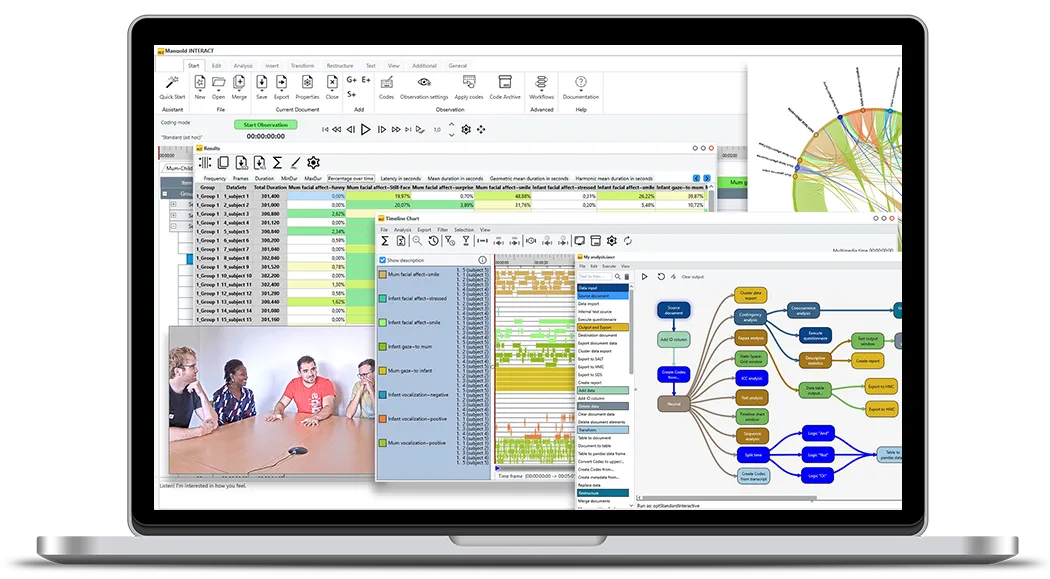Tutorial · 4 min read
How to Synchronize and Analyze Multiple Media Files in Mangold INTERACT
Learn how to open, sync, and manage multiple media files in Mangold INTERACT for accurate behavioral research and video analysis.
How to Synchronize and Analyze Multiple Media Files in Mangold INTERACT
If you’re conducting behavioral research, video analysis, or any type of multimedia observation, chances are you’ll need to work with more than one recording at a time. That’s where Mangold INTERACT shines. This powerful research observation software allows you to open, synchronize, and analyze multiple media files simultaneously—whether they’re audio, video, or both.
In this guide, we’ll walk through everything you need to know about working with multiple media files in Mangold INTERACT, from opening and syncing videos to troubleshooting performance and aligning independent recordings.
What You’ll Learn in Just a Few Minutes
- Open files via the Recent Media list, Start tab, or by dragging them from your system
- Play multiple files in sync on the same timeline
- Resize and position video windows across monitors
- Identify the “master” video and sync other files to it
- Troubleshoot playback issues and check system performance
- Manually synchronize recordings from independent devices
- Apply virtual offsets to ensure perfect playback alignment
- Fine-tune timing for precise observation
Opening Multiple Multimedia Files in INTERACT
Mangold INTERACT gives you several flexible ways to open your media:
- Use the Recent Media Files list
- Open files via the File Open menu on the Start tab
- Drag and drop directly from Windows Explorer or macOS Finder
You can open one file at a time or multiple at once. Each media file appears in its own resizable window, which can be arranged across multiple monitors—ideal for researchers working with multi-camera video recordings.
Playing Multiple Videos in Sync
One of INTERACT’s most powerful features is the ability to play all videos perfectly synchronized on a shared timeline. This ensures that your behavioral coding and event logging align across every media file.
Here’s how it works:
- The first file you open becomes the time master, marked with an [M].
- All other media sync to this master timeline.
- To avoid playback issues, always open the file with the highest frame rate first.
💡 Tip: The number of recordings you can run depends on your computer’s hardware. If playback is lagging or stuttering, use Task Manager (Windows) or Activity Monitor (macOS) to check for high CPU, RAM, or GPU usage.
Managing File References
Whenever you start an observation, INTERACT automatically creates a file reference in the dataset’s transcription area. This makes it easy to:
- Reopen all your files with just a double-click
- Control which recording acts as the master video
- Save sync settings (so you don’t need to redo them)
⚠️ Important for researchers: Always reopen synced recordings from the dataset reference. If you open them manually, your synchronization settings will be ignored, causing misaligned playback.
Synchronizing Independent Recordings
Not every recording starts at the same moment - especially if you’re using multiple cameras or recording devices. With INTERACT, you can easily manually synchronize recordings.
The process works best if you use a clear synchronization signal, such as:
- A hand clap
- A flashlight or clapboard
- A visible digital clock
To manually sync:
- Stop the Observation mode if active.
- Open the Multimedia Settings for a video.
- Use the slider or arrow keys to align it with your chosen signal.
- Close the settings dialog to save the offset (measured in milliseconds).
- Repeat for each file.
These offsets allow INTERACT to virtually adjust the start time of each recording - without altering the original media files. This is essential for synchronized behavioral research analysis.
Why Synchronization Matters in Research
Accurate synchronization is critical in behavioral science, usability testing, and video-based research. With Mangold INTERACT, you can:
- Align multi-camera recordings
- Log observations on a shared, synchronized timeline
- Eliminate unnecessary pre-session material
- Ensure playback consistency across all datasets
By combining powerful multimedia synchronization tools with flexible data management, INTERACT helps researchers focus on insights rather than technical obstacles.
Final Thoughts
Working with multiple media files in Mangold INTERACT is straightforward once you learn the workflow:
- Open your files
- Synchronize them (automatically or manually)
- Manage references and offsets
With these steps, you’ll ensure your video analysis projects are accurate, efficient, and ready for coding and interpretation.
Video Tutorial
👉 Watch our full YouTube tutorial for a step-by-step demonstration, and don’t forget to like, subscribe, and explore our other Mangold INTERACT tutorials for more tips on speeding up your research.
INTERACT: One Software for Your Entire Observational Research Workflow
From audio/video-based content-coding and transcription to analysis - INTERACT has you covered.
